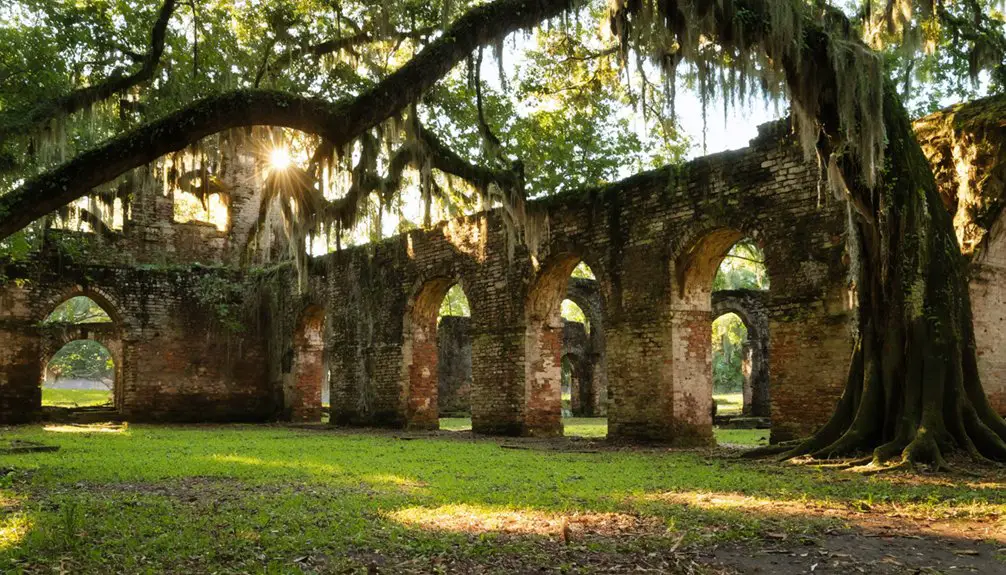You’ll find Ruby City’s remains in North Carolina’s historic Moses reservation, where an 1886 quartz discovery sparked a mining boom. The town quickly grew to over 1,000 residents by 1888, thriving on garnet and corundum mining until 1928. Today, scraggly pines and dense shrubs cover the ghost town‘s wooden structures and mining shafts, while faint excavation marks hint at its bustling past. The site’s mysteries, including undiscovered ruby sources, continue to intrigue visitors and historians alike.
Key Takeaways
- Ruby City flourished in 1886 after quartz discoveries on Ruby Hill, growing to over 1,000 residents during the North Carolina mining rush.
- The town primarily mined corundum and garnets for industrial use, despite marketing itself as a ruby mine to attract investors.
- Infrastructure included wooden houses, tents, a general store, saloon, and mining operations with a 20-foot shaft and wire tramway system.
- Economic decline began in the late 1800s due to poor ore quality, leading to mine closures and eventual abandonment of the settlement.
- Today, nature has reclaimed Ruby City, with pine trees and shrubs covering former buildings, leaving only faint traces of mining operations.
The Rise of a Mining Settlement
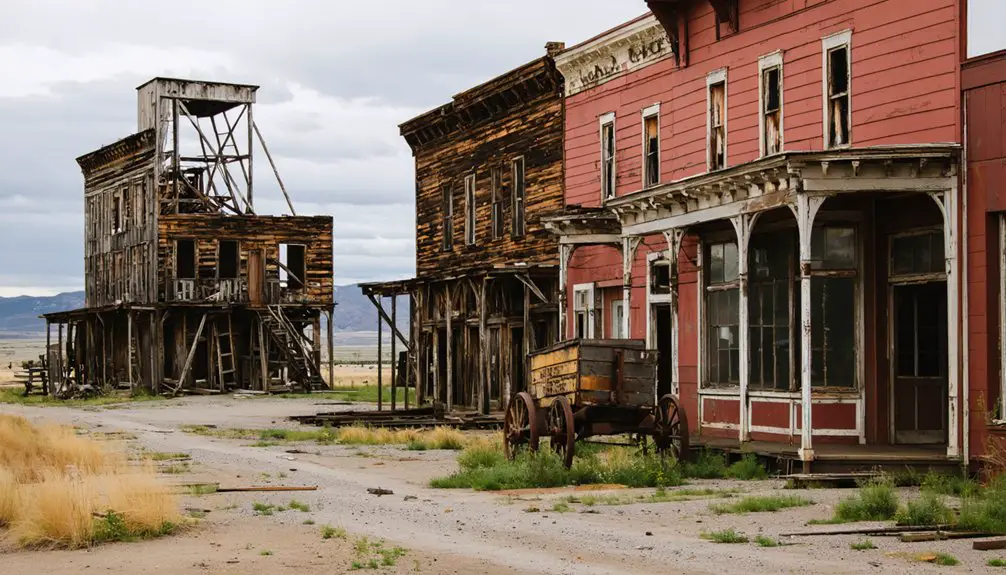
When prospectors discovered promising quartz ledges on Ruby Hill in 1886, Thomas D. Fuller and his associates quickly organized what would become Ruby City.
You’ll find that this settlement emerged during a series of mining rushes that swept through Okanogan County after the Moses reservation opened for settlement. The initial claims, staked by Fuller along with John Clonan, Thomas Donan, and William Milligan, revealed an impressive 18-foot-wide ore ledge within the granite and gneiss formations.
The community dynamics shifted rapidly as word spread of the discovery, bringing waves of prospectors enthusiastic to strike it rich. By 1888, the bustling town had grown to include over a thousand residents.
Despite strict mining regulations governing claim registration, Ruby City’s population swelled as workers and entrepreneurs arrived to tap into the area’s mineral wealth, though the settlement wouldn’t become the region’s premier mining district.
Life in Ruby City’s Heyday
As mining activity intensified in Ruby City during the late 1880s, the settlement’s daily life took shape around its mineral-seeking residents.
You’d find simple wooden houses and tents lining the dusty main street, while a general store and saloon served as the town’s commercial hub. Transient workers came and went with the mines’ fortunes, creating an ever-shifting population.
Community gatherings at the saloon offered respite from the harsh realities of mountain life. You’d see miners trading stories over drinks, while their families dealt with limited supplies and basic living conditions.
The town’s remote location meant you’d face challenging transport by horse or wagon, especially during winter months. When mines prospered, the community thrived; when they faltered, Ruby City’s liveliness quickly diminished.
Mining Operations and Economic Impact
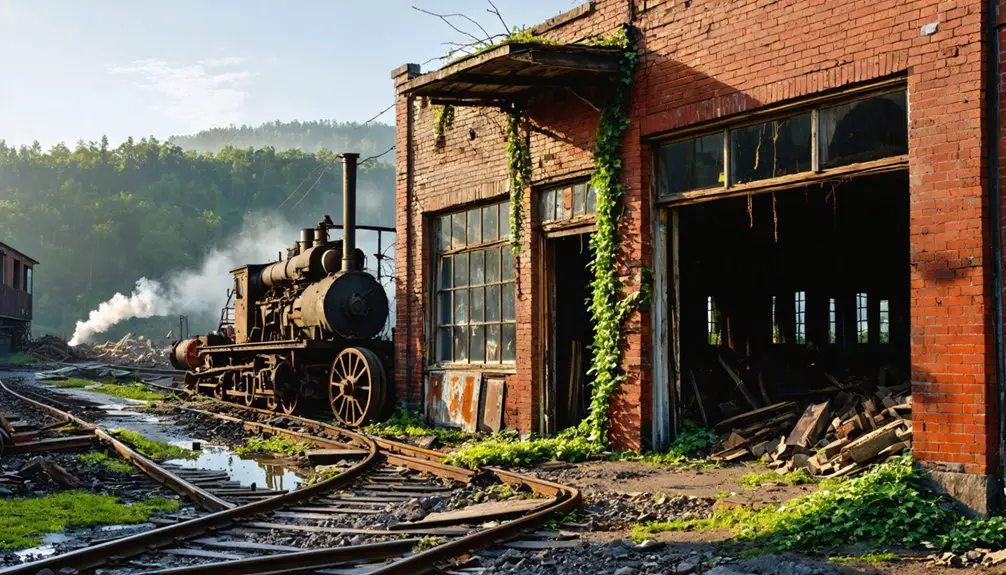
During its peak from 1890 to 1928, Ruby City’s mining operations focused primarily on extracting pyrope garnet and corundum for industrial abrasives, not the precious rubies that gave the town its optimistic name.
You’ll find that the mine employed roughly 30 full-time workers at its height, providing stable jobs for local families until Canadian competition forced its closure.
While the operation marketed itself as a ruby mine to attract investors, its main economic value came from processing minerals for practical applications like sandpaper manufacturing.
Primary Mineral Resources Extracted
While corundum served as Ruby City‘s primary mineral resource, the area’s deposits yielded both precious gemstones and industrial-grade materials.
You’ll find that corundum characteristics made it particularly valuable, ranking just below diamond in hardness. The deposits primarily occurred in creek gravel beds and valley flume lines, where miners discovered both rubies (red corundum) and sapphires (blue corundum).
- Corundum was extracted for both gemstone value and industrial abrasive applications
- Local creek beds contained rich alluvial deposits of various gem minerals
- Associated minerals included valuable mica and kaolin deposits
- Garnets, moonstones, and rhodolite were part of the gem assemblage
- Sillimanite and rutile added to the area’s mineral diversity
The region’s unique geology created ideal conditions for these mineral formations, making Ruby City a significant source of both precious and industrial minerals.
Peak Production Years
From 1890 to 1928, Ruby City Mine flourished as a significant industrial operation in Macon County, employing roughly 30 full-time workers at its peak.
During these years, you’d find wagons transporting industrial-grade garnets to nearby railroads, where they’d be shipped to manufacturers for use in sandpaper and other abrasives.
The mine’s peak production years aligned with the region’s reputation as the “Gem Capital of the World,” though high-quality gems proved elusive.
While mining technology supported extensive extraction operations, the facility primarily processed non-gem grade pyrope garnets.
Local Employment Numbers
As Ruby City’s mining operations expanded, employment numbers grew from several dozen workers in the early years to a peak workforce of a few hundred during the height of garnet production.
Employment trends reflected the town’s economic dependence on mining, with workforce demographics spanning skilled operators, technicians, and entry-level laborers.
You’ll find the mining jobs formed the backbone of Ruby City’s economy, with wages averaging $18-20 per hour in comparable roles across North Carolina.
- Skilled positions included drill operators and blasting experts
- Entry-level positions offered on-the-job training opportunities
- Supervisory roles guaranteed safety and operational compliance
- Support jobs emerged in equipment maintenance and transport
- Mining salaries created a multiplier effect, supporting local businesses
The town’s fortunes closely followed mining employment levels, ultimately leading to its decline when operations ceased.
The Town’s Infrastructure and Layout
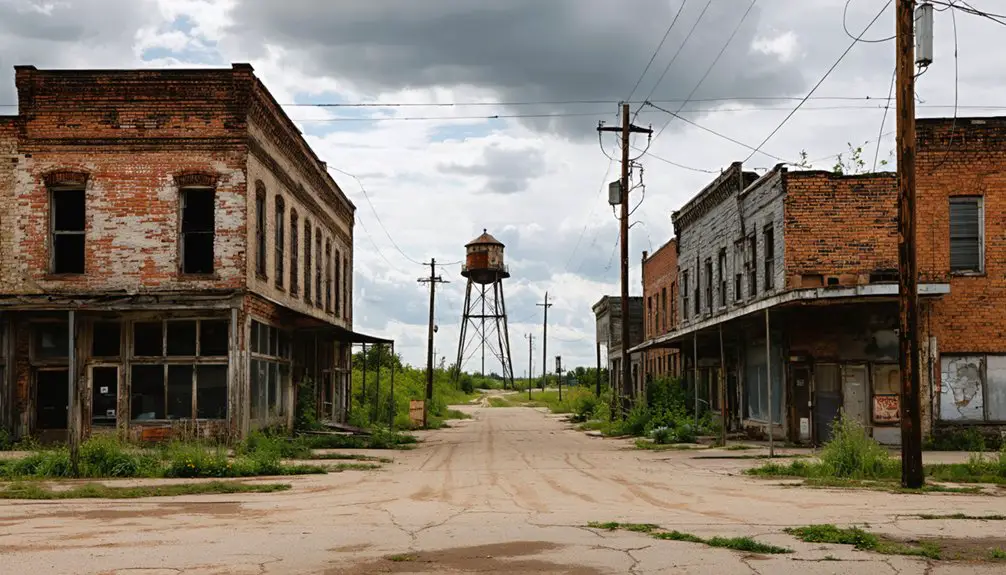
You’ll find Ruby City’s main street was practically arranged around the mining operations, with most structures concentrated near the concentrator plant and tramway system.
The buildings were constructed using sturdy materials to withstand the harsh North Carolina mountain climate, reflecting the town’s utilitarian focus.
The mining operation structures, including the concentrator located half a mile east of town and the wire tramway system, formed the industrial backbone of Ruby City’s layout.
Main Street Configuration
While Ruby’s Main Street might seem like a typical mining town thoroughfare, it served as the crucial artery connecting the town’s residential zones to its eastern mining facilities.
The urban planning reflected a practical approach, with the street’s linear layout accommodating both the tram system and pedestrian traffic. You’ll notice how the street’s alignment worked with the natural landscape, making it easier to transport materials and miners between the town center and industrial areas.
- Wire tram system crossed or paralleled Main Street to reach the concentrator
- Commercial buildings clustered along the thoroughfare for maximum accessibility
- Dirt or gravel surfaces suited the era’s transportation needs
- Strategic intersections led to critical mining infrastructure
- Loading zones positioned near key operational points
Building Construction Methods
Since Ruby’s harsh mountain environment demanded practical building solutions, the town’s construction methods relied heavily on locally sourced materials and simple, effective designs.
The silver mining operations fueled rapid construction during the town’s peak years. You’ll find that builders maximized the region’s abundant timber sourcing, using pine and hardwood for most structures. They’d elevate buildings on stone foundations or log piers to combat ground moisture and provide ventilation in the challenging mountain climate.
The post-and-beam framing technique allowed for quick assembly, while locally quarried stone reinforced chimneys and foundational elements.
You can spot the evolution of roofing materials, from wooden shingles to more durable corrugated metal. Construction typically paused during severe weather, and builders adapted their techniques to the uneven terrain, creating stable structures that could withstand the mountainous environment’s demands.
Mining Operation Structures
The heart of Ruby City’s mining operations centered around a prominent 20-foot shaft and two prospect pits, where early explorers searched for precious gems in the region’s mica gneiss bedrock.
You’ll find the mining structures arranged strategically along gem-bearing veins, with shaft stability maintained by the natural characteristics of the surrounding rock formations.
- Main shaft penetrates vertically through N. 40° E striking gneiss
- Prospect pits served as initial exploration points before deeper mining
- Storage sheds and worker shelters positioned near active mining areas
- Mineral processing stations established for sorting and washing gems
- Small-scale infrastructure designed for tourist accessibility
The layout maximized operational efficiency while preserving the area’s natural beauty, connecting seamlessly to Highway 441 and Franklin’s commercial district through a network of secondary roads and paths.
The Path to Abandonment

Deeply rooted in mining’s boom-and-bust cycle, Ruby City’s path to abandonment began when its mineral-dependent economy started showing cracks in the late nineteenth century.
The town’s economic vulnerability became apparent as ore quality diminished and mining operations struggled to maintain profitability in the challenging mountain terrain.
You’d have witnessed the town’s community resilience tested as mining companies relocated, leaving workers jobless and families seeking opportunities elsewhere.
The exodus triggered a domino effect: shops closed, schools emptied, and infrastructure crumbled. Without economic diversification beyond mining, Ruby City couldn’t sustain itself.
The harsh mountain environment and limited transportation options further isolated the struggling community.
As mining operations ceased completely, the town’s remaining residents departed, leaving behind empty buildings as silent testimonies to its mineral-driven rise and fall.
Natural Reclamation and Present-Day Site
Nature’s relentless march transformed Ruby City into a living evidence of ecological succession, where scraggly pine trees and dense shrubbery now dominate the former mining settlement.
You’ll find this ghost town near Willets in Jackson County, where it’s protected within the Balsam Mountain Preserve. Time and weather have erased most signs of human habitation, though keen eyes can spot traces of foundations and old roadbeds beneath the vegetation.
- Faint excavation marks line former main streets, revealing the town’s original layout
- Native plant species have reclaimed cleared areas, restoring natural habitat
- Wildlife has returned to thrive in the absence of human activity
- Freeze-thaw cycles and plant roots gradually break down remaining structures
- The site serves as evidence to nature’s power to heal disturbed landscapes
Legacy in North Carolina’s Mining History
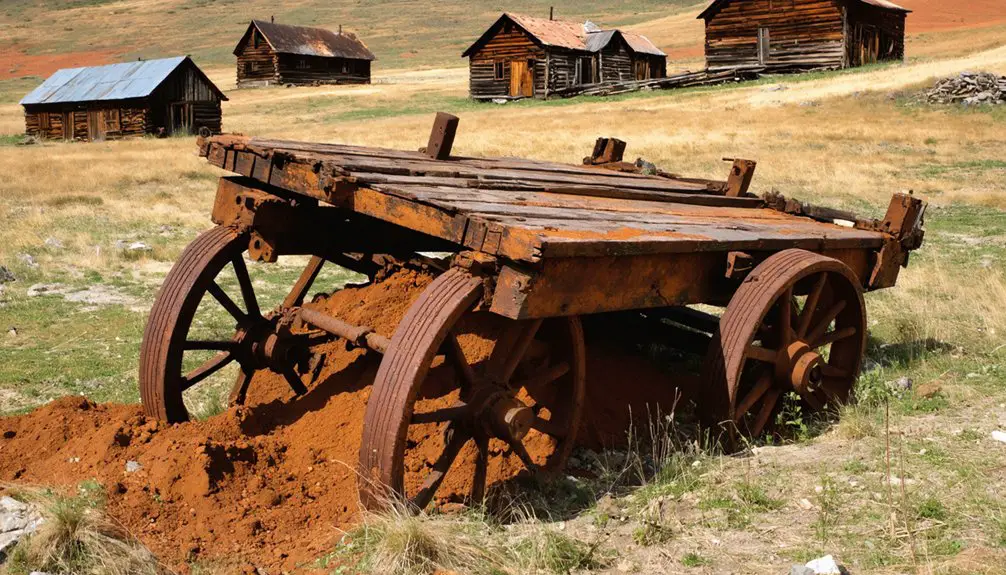
While nature steadily reclaims Ruby City’s physical remains, its enduring influence on North Carolina’s mining heritage lives on through a rich legacy of mineral exploration.
You’ll find its pioneering spirit in the region’s geological significance, from the 1870 discovery of corundum to Tiffany’s interest in the 1890s. The area’s mysteries, including the undiscovered source of its prized rubies, continue to captivate gem enthusiasts worldwide.
Today, you’ll experience this heritage through gem tourism at places like Cherokee Ruby & Sapphire Mine and Rose Creek Mine. These operations preserve the region’s mining traditions while offering you hands-on adventures in gem hunting.
Ruby City’s story remains woven into North Carolina’s identity as a premier destination for mineral exploration and discovery.
Frequently Asked Questions
Are There Any Documented Accidents or Deaths From Ruby City’s Mining Operations?
You won’t find any documented mining deaths or accidents in Ruby City’s historical records. While mining safety was a major concern in North Carolina, there’s no evidence of tragedies at this specific site.
What Happened to the Mining Equipment After the Town Was Abandoned?
You’ll find most mining equipment was left to rust, with locals salvaging pieces for farm tools and scrap metal. Without historical preservation efforts, the machinery gradually disappeared through scavenging and natural decay.
Did Any Notable Historical Figures Ever Visit Ruby City?
You won’t find records of any famous visitors to this small mining settlement. Historical significance was limited to local mining operations, with no documented visits from notable figures or dignitaries.
Were There Any Conflicts Between Mining Companies and Local Native Americans?
You’re barking up the wrong historical tree – Ruby City was actually in Washington state, not North Carolina, and there’s no documented evidence of land disputes or cultural impact with Native Americans there.
What Artifacts Have Been Discovered at Ruby City in Recent Years?
You’ll find square nails from 1890s graves, mining artifacts like drills and carts, fluorescent minerals, and Native American tools of historical significance discovered through GPS and metal detecting since 2004.
References
- https://www.youtube.com/watch?v=rsV_cHE7u1U
- http://www.ghosttownsusa.com/ruby2.htm
- http://www.ghosttownaz.info/ruby-mining-ghost-town.php
- https://kids.kiddle.co/List_of_ghost_towns_in_North_Carolina
- https://en.wikipedia.org/wiki/List_of_ghost_towns_in_North_Carolina
- https://balsammountainpreserve.com/history/
- https://www.ncpropertysells.com/default.asp?content=custom&menu_id=215482
- https://www.ncpedia.org/mining
- https://www.mindat.org/loc-32045.html
- https://www.youtube.com/watch?v=HoeooHHF5k0



